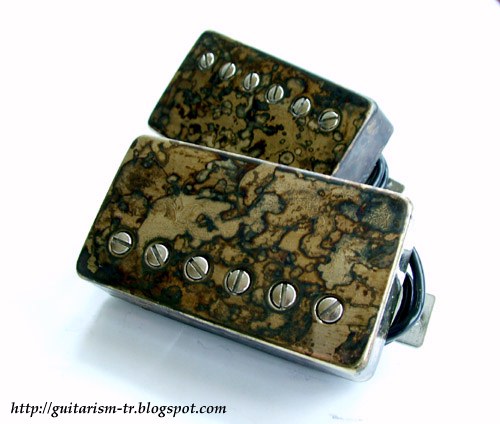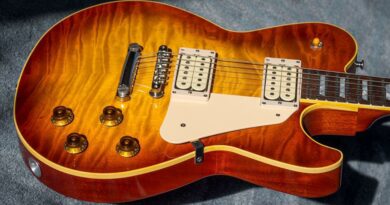Q&A: Tim Mills of Bare Knuckle Pickups
Tim Mills interview by Guest Contributor
Q: Hi Tim. I like to open with a cliche question, I’m pretty sure that you’ve answered a lot. Can you tell us about you and your very first beginnings about the interest to guitar sound, guitar playing and of course pickups?
Tim Mills: I started playing guitar relatively late around the age of 15 I guess and as with all of us, once the bug had bitten I was hooked. After finishing school I set off playing in a variety of bands both here in the UK and then in Germany. I quickly found out that making a living from music wasn’t as easy as I thought so I returned to the UK and started teaching guitar privately, steadily building up a good roster of students which kept me going and learning at the same time.
Also at this time I was very actively involved in a metal band with my wife on vocals and we toured the UK extensively as well as opening for other main touring acts and doing several sessions for Radio-1. It was through the teaching that I started working for British blues rock singer Elkie Brooks – after teaching her son guitar I was soon being asked to play on tracks in her studio leading to whole albums and then becoming part of her touring band which I did through most of the ‘90s.
Coming from a predominantly rock and metal playing background and finding myself in a band with some seriously good session players was a real eye opener and a steep learning curve but it did me a lot of good and I learnt masses about playing, production and writing.
For the past 10 years I’ve played in an Ozzy tribute band here in the UK – essentially a group of my closest friends which still gives me the chance to get out and play without the pressure of touring all the time. It also gives me the opportunity to test pickups in a live environment which is something I’ve always done since day one and have grown to rely on as the final bench mark of a pickups performance.
In between all of that I have worked for American metal band Iced Earth contributing some solos to one of their EPs as well as writing some tracks for a couple of their albums with Jon Schaffer. I also very briefly did some writing and playing with Chitty Somapala in Germany as part of a band called Civilization One but by this time Bare Knuckle was absorbing all of my spare time and I couldn’t manage to keep travelling back and forth to Germany.
Right now I still get to go out and play with the tribute band – it’s called No Rest for the Wicked and it’s simply the best fun ever. I get the chance to play the guitar parts of Rhoads, Lee and Wylde which are both challenging and enjoyable. I’ve also just started recording some original material helped by Red Seas Fire guitarist Adam Getgood which will feature both the guys from the band and my wife which I’m very excited about. I’ve no idea how long it’ll take as my priority is always Bare Knuckle but it’d be nice to think it’ll see the light of day at some point.
Q: Tight schedule, hm? As far as I know you have very detailistic approach to your PAF style vintage humbuckers. Most of them are really historically correct. What’s your complete vision about PAF type pickups?
Tim Mills: As arguably one of the first production humbuckers the PAF is an extremely important pickup that any pickup maker has to study as it forms the foundation for all subsequent humbuckers.I would argue that they weren’t all good, in fact a lot of them don’t sound good at all and can be quite one dimensional. However, out of all the genuine PAFs I have worked on, you get some that really are head and shoulders above the rest and sound absolutely wonderful. When one of those comes into the workshop I go over it with a fine tooth comb and document everything about it, most importantly its sound.
There is a lot of debate about PAFs being hand wound or machine wound. None of us were there so we can only speculate by analyzing the pickups we have left from that era. Whilst undoubtedly wound on a machine, there is a good argument for suggesting that PAF coils were also being hand-wound alongside to keep up with production. Gibson certainly had hand-winding machines for winding P90s on so it seems logical that these would be used too. I personally prefer to hand wind – in fact it is the only way we wind pickups at Bare Knuckle.
It’s well known that the number of turns on original PAF bobbins varied considerably from coil to coil but the windings themselves, whilst not deliberately scatter-wound like on Fender coils, were random enough to indicate a degree of hand winding at least until Gibson acquired another machine capable of auto-shut off in the early ‘60s.
Q: Mentioning PAFs, what do you think about real PAF pickups with extremely high prices? Do you think they worth buying for or just let them just a part of history?
Tim Mills: The vintage parts market is a bizarre one and not something I profess to understand. Because there are so few original PAFs in existence they will always command a high price. The real question is if you buy a genuine PAF for a lot of money, will you be too afraid to use it because of the value of the pickup. I personally like to use all of my instruments and not lock them away because I am too scared they might get damaged or stolen. We make some extremely accurate vintage reproduction pickups at Bare Knuckle, as do several other makers, and I think this is a much more practical approach if you want to recreate the original tone with a sensible budget.
Q: Some of your pickups have relatively uncommon magnets. Like Apache Strat Single set has Alnico III. Mules may have Alnico IV which is my favourite magnet to tame bridge humbuckers with Alnico Vs, if customers choose. Can you tell us what your aim to give that option is?
Tim Mills: We use these magnets to be historically accurate to the original pickup designs and the magnets used during the 1950s.
I spent a lot of time having original magnet samples form the early ‘50s and ‘60s analysed as well as looking at magnet strength and how that had altered over time. In the end I had to balance my findings between what was historically accurate and what sounded the best – I will always go with what will reproduce the best tone.

Even though Seth Lover stipulated Alnico V on the original PAF design, Gibson continued to use existing stock of Alnico II and III bar due to the cost, later using Alnico IV and eventually Alnico V by late 1960.
I have found all kinds of Alnico grades in magnetic rod from Fender coils during the ‘50s ranging from very low grade generic Alnico to Alnicos closer to the grades we know as Alnico II, III and V today – even mixtures of different rod on the same coil.
Q: You have very intense approach on your PG humbuckers. Peter Green is one of the greatest players ever lived. Thus his tone with his famous Les Paul is still considered top of the line (Yes, i’m one of his fans). Until your pickup set, it is always flipped magneted neck humbuckers to be suggested to achieve his unique “out of phase” tone when two pickups work together. Your PG set has something more. Can you please give us some details about your history, journey, design, test and finally presenting stages of Bare Knuckle PG set?
Tim Mills: I’ve always been aware of the mystery surrounding the famous Peter Green out of phase mid position tone but it wasn’t until I had a request to build a set for Chris Rea’s drummer that I really started to investigate and try to get to the bottom of what had happened to the pickups in Peter’s ’59 LP.
The commonly accepted story is that the neck pickup had a flipped magnet, probably a mistake during assembly at Gibson. However as I started to dig a bit deeper I was lucky enough to speak to several people that knew Peter very well and a story started to emerge that the neck pickup in his guitar had broken at one point leading to him getting it repaired. A colleague then came across pictures of Peter playing the LP without a neck pickup and prior to that, a piece of film of him playing where he was clearly struggling with a failing neck pickup (tapping it trying to get it to work).
I then learnt of a guitar repair man called Sam Lee who claimed to have repaired the neck pickup, rewinding the coils using a record player with a copper colored wire he took to be heavy formvar. He said that he thought he had rewound the bobbins the wrong way because when he re-assembled the pickup it worked perfectly on it’s own but was out of phase with the bridge. He promptly turned it around in the pickup ring mistakenly thinking it would correct the phase – he said that Peter never complained so he assumed he had sorted it out.
After this I spoke with a luthier who had to repair the neck on the PG LP when it was owned by Gary Moore. Gary was involved in a car accident and the guitar which was in the back of the car got damaged and the neck needed attention. This luthier had to remove the neck pickup to repair the neck and removed the cover to see if the coils were damaged. He confirmed that the coils had been rewound with what he took to be heavy formvar.
So which is the true story? Magnet flip or reverse wound coils? Two things I will say are the guitar was modified many times when Gary Moore owned it with different wiring, even push pull pots at one point so I think it’s far to say the pickups could have been changed from the originals at some point. Secondly, I experimented with both magnetically out of phase mid position and with electrically out of phase mid position tone and I thought that the most convincing was with the coils wound in reverse especially when wound with heavy formvar wire.
I set to listening and watching whatever I could of Peter playing and using this out of phase tone and I noticed that he would constantly adjust his volume pots when in the middle position – this would vary the amount of out of phase tone, the stronger pickup essentially correcting the phase. Armed with all of this knowledge I set to voicing a set of humbuckers which became the Bare Knuckle PG Blues set.
The first set went off to be installed by Charlie Chandler in Chris Reas’s drummers LP and while testing the guitar in his shop several customers heard it and tried it out – all immediately ordered sets. One of these players was Gary Moore who went on to order two sets which were installed in LPs he used for the Peter Green numbers in his live set. Gary said I had nailed the tone and they sounded the same as the original LP. That was good enough for me!
Q: Wooaw, that’s huge amount of effort! One of the most interesting humbucker of BKPs seemed “The Mule” to me. It has very cool model name, referring to the great player Warren Haynes of Gov’t Mule. The construction of the pickup itself, you know, the magnet, DC resistance value, the materials used… Can you tell us a bit about the mule, what was in your mind to create something like this?
Tim Mills: Yes I was listening to a lot of Govt. Mule at the time (and still do) and I thought the name was appropriate as not only does the band produce some great music but a Mule is renowned for a serious kick which was perfect for the voicing I was working on.
Every pickup maker has their version of the original PAF- we all try to make the best and most historically accurate one possible. I tried to take a balanced approach based on analysis and the tone of originals along with what my hands and ears told me. I’ll always go on what I hear and feel over a bit of science but needless to say I’ve raked over ever detail of original PAFs from the metals used to the plastics and all points in between. I would also acknowledge the huge amount of help I have had from friends and players in the business without whom I wouldn’t know a tenth of what I know now.
I’ve been fortunate enough to have had a lot of very good examples of original PAFs come through the workshop. You can see a lot of pictures in the gallery on our website. These have included repairs on PAFs belonging to Martin Barre and Steve Howe and I’ve been lucky enough to work on Jimmy Page’s No.1 LP too. Everything I have learnt from working on these PAFs has gone into The Mule and also the Stormy Monday and Riff Raff humbuckers which represent different parts of the PAF time line.
Everything we make is made with our own tooling – butyrate humbucker bobbins, nickel silver baseplates, pole shoes, screws, slugs, maple spacers you name it, we make it and they’re all accurate to the original PAF design even down to the original tooling marks. You can buy original PAF covers for crazy money these days and even other so called repro covers are hundreds of pounds but I’m glad to say that when you buy a BKP you get a 100% accurate PAF cover as standard.
I was lucky enough to have a very good friend with some excellent examples of original covers that we could use as reference and also an exceptionally good engineer who was as obsessed as I was to get it just right. It took the best part of a year to finalise the tooling before we were happy and then the search was on to get exactly the right German nickel silver and get the plating perfected.
I think it’s crucial to develop and make your own parts for both consistency and quality of the finished pickup and most importantly the sound.
Q: Indeed! Let’s, also, talk about your Strat pickups which seem they have your detailistic approach, too. Plus some models get attention like “Apache”, “Mothers Milk”, “Irish Tour” and “Slow Hand”. What’s your general approach to design a single coil for strats?
Tim Mills: When I first started out I decided to offer a range of Strat coils based more on the tone I wanted to present through the voicing than any particular period in the evolution of the Stratocaster. As our range grew I started to add period correct sets as well to accommodate players that were looking for exact vintage specs.
I design my Strat coils using the same approach I use for all my pickups starting with studying the original pickup design and then balancing that with the application.

Q: There are many fans of Eric Clapton and Rory Gallagher in Turkey (ed. Prof Guitarism’s home) and so I believe they will keen on about those sets. Can you please give some details about creating those models? Could you have a possibility to inspect their certain guitars or pickups for instance? Or is it pickups of “Blackie” or “Brownie” that you had inspired?
Tim Mills: No, I have never had the opportunity to see any of Eric’s or Rory’s guitars (although I would love to) but I do know people who have worked on both.
I’m aiming to create a vibe really so I don’t use any one song or guitar as reference.
A pickup is one part of a chain that creates your tone with the most important link being you, the player. To make any pickup, or any piece of equipment come to think of it, and say ‘this will exactly replicate so and so’s sound’ is unfair as the core of that players sound is what they’re actually playing. What we can do is get you into the right ballpark to start with and for me that means getting as close to the original pickup tone and performance as possible so I’ll start with the spec of the original pickup as reference.
Occasionally I’ll do it based purely on the tone from available recordings. Rory picked extremely heavily with hefty strings and high action through an amp cranked flat out. Most of us mere mortal players will never get within a mile of that style of playing using vintage output coils like Rory but by winding the coils differently and altering the output and response I can at least get us into the right output ballpark and tonal response. The rest is going to be down to practice.
and Painkiller w/ Burnt Chrome Covers
Q: You have good fame in the extended range guitarists with your extended ranged pickups. So you have 7th and 8th stringed versions of your standard line. Is it difficult to get the same sound for extended ranged guitars? You know, you can get a cool sound for standard guitar but this balance may ruin the low B sound too muddy. Do you alter the specs, turns or magnets to make 7th or 8th stringed versions?
Tim Mills: To be honest it all depends on how the 7 or 8 string (we even make 9 string now) guitar is going to be used – what tuning, what string gauge etc.
As a general rule I advise players of extended range instruments not to go for high output pickups. The longer the scale length of the instrument the brighter it gets and with heavy gauge strings and lower tunings there’s more string mass moving in the magnetic field of the pickups so if you’re not careful you can end up with all boom and hiss from a high gain humbucker.
When I was doing the recording work with Iced Earth we had to rerecord several older IE tracks for an EP and to give them a different edge we decided to uses baritones instead of regular guitars. We spent quite some time trying all kinds of different pickups with the high gain heads that were being used and the best results always came from the lower output pickups.
Again, it does boil down to the player and how they use their guitar so this isn’t a golden rule by any means and there is always going to be the exception to the rule where a medium or even high output humbucker will be required.
Q: Why do people must/should choose Bare Knuckle instead of other products, what are the advantages of Bare Knuckle products?
Tim Mills: We aim to help players find the right tone and then back that up with the highest quality of production and customer service so that they can concentrate on the job in hand which is being inspired to play guitar and make music.
Q: I see very impressive rock legends in your user list like John Sykes, Steve Howe, Scott Gorham, Adrian Legg. And mainstream rock stars like Lenny Kravitz and Brain Molko. Plus, I know that many extreme metal guitar players with extended range guitars prefer your pickups. To be preferred by guitarists from nearly every genre must be a real success to me. What was your secret about this?
Tim Mills: They are all customers the same as everyone else and I am a firm believer in treating all of our customers equally and with the same level of attention and service. Someone just starting out playing guitar is as important to me as someone who tours the world in a famous band and we value them all. As a company we learn from all of them and that interaction helps me develop what we do and what Bare Knuckle can offer so that we produce the most relevant and practical pickups possible.
I think the wide range of artists and playing styles of our users reflects the range of pickups we offer and hopefully reaffirms that we are moving in the right direction with what we make.
Q: Do you think that the emergence of “boutique” winders in early 2K and their continued success for the remaining part of the decade, hurt sales and reputation of bigger companies like DiMarzio and Seymour Duncan?
Tim Mills: They say that competition is a good thing and I’m sure that the emergence of boutique winders will have encouraged the larger manufacturers to look to their game plan and work hard at what they do.
I don’t think boutique winders hurt the reputation of companies like Seymour Duncan or DiMarzio nor would anyone want to. They are the fore runners of our industry and as such deserve respect for the products they have brought to the market place and for the innovations they continue to push. Without these companies there would be no boutique winders simple as that.
Q: I also have some more kind of technical questions for you; First of all, I like to ask you about wax potting. According to my personal experiences over potting ruins a pickup. But several months ago I had made an interview with Steve Blucher of DiMarzio. He clearly stated that properly made wax potting had no effect to pickup performance. I notice you give potted and unpotted options for your pickups so that I like to learn about your thoughts about potting.
Tim Mills: I can only talk from my own experience and I personally find a huge difference in tone and dynamics between unpotted and potted coils.
By comparison to potted coils, unpotted coils produce a brighter tone with an extremely lively picking dynamic. The coil windings and the microscopic air gaps between the windings are able to oscillate with the string vibration causing the sound to be on the edge of feeding back. The traditional practice is to pot coils in a mixture of paraffin and bees wax (although it is possible to pot using a variety of different methods) and the amount of time a coil is potted will affect its dynamic response.
Potted and unpotted coils appeal to different types of player and we therefore offer either option for our vintage humbuckers. Our higher output humbuckers are always potted as these are invariably used in high gain and volume situations where any benefit would be lost through uncontrollable feedback.
Q: What do you think about active pickups? There is a clear market for ultra hi-gain active humbucker arena. This arena was used to rule by EMG till Duncan releasing Blackouts? Does Bare Knuckle have plans for this active pickup market? I also like to know your comments about active pickups…
Tim Mills: Personally I think active pickups are great. For players looking for an extremely clean sound with a lot of output and compression they can be ideal especially as they sound consistently the same from instrument to instrument.I don’t have any plans to produce actives, I feel no one has bettered EMGs original design and prefer to stick with the passive designs that I know and enjoy making.
Q: What does scatter winding affect to the tone of your humbuckers and single coil pickups?
Tim Mills: Scatter-winding is normally only ever done by hand, at least that’s the way I’ve always done it and represents a high degree of skill by the person winding the coil. Although time consuming, it has many advantages over conventional machine winding and mass-production, not least the far superior tone and dynamics produced.
I deliberately scatter the wire as I build up the windings of the coils so the wire isn’t as even turn on turn, layer on layer, as with the more uniform wind of an automated machine with pre-tensioning. This lowers the distributed capacitance that exists between the turns of wire. Lower capacitance means improved high-end clarity, the resonant peak increases slightly and frequency response is greatly extended. The tension of the wire is also varied as it moves through my fingers so I have complete control over the tension of the wire as it goes onto the coil. The result is a clearer, more open tone that has the impression of being louder purely by the amount of extra detail and dynamics present.
I’m totally committed to hand winding and if I didn’t think it made a considerable improvement to the tone I simply wouldn’t do it. I also happen to enjoy it too!
Q: According to your website, VHII has asymmetrical coils. Do you refer unmatched wound humbuckers or the bobbins wound with different gauged wires with the phrase “asymmetrical”? What was your approach to wind bobbins like that?
Tim Mills: By asymmetrical coils I mean two coils with different numbers of turns of the same gauge wire not different gauges of wire. I started experimenting with this after looking at early Gibson humbuckers wound before they used an auto shut off winder. I found that the number of turns on each bobbin varied by several hundred turns and this was one of the contributing factors to the clarity and tone of these pickups. By adjusting the number of turns between the two coils you can control the mid range and high end response of a humbuckers and this is something I do with a lot of my designs.
Q: Do you de-gauss your magnets to achieve more kind of vintage sounds? Or are they fully charged?
Tim Mills: It depends on the magnets being used; ceramic magnets I use with as near full charge as they will hold but the Alnico grades we use are charged according to the pickup they are to be used in. I’m not a fan of heavily de-gaussing magnets as there comes a point where the coil is not being driven properly.
Q: Can you give us some details about your rewind service? Is it just repair-wise or do you offer more with rewinds?
Tim Mills: Our rewind service is for the repair of broken pickups only. We keep a full range of vintage correct wire for restoring old pickups but we don’t get involved in rewinding working pickups as we have our own range of pickups which I have spent my time on developing and voicing. To try and turn another manufacturer’s pickup into your own is always going to be a compromise and I prefer not to do it.
Q: Who are your inspirations on pickup making?
Tim Mills: I’m inspired by all of the original pickup designers really – without them I wouldn’t be doing this, in fact without them I probably wouldn’t be playing guitar! I also have a very close friend who prefers not to be named who has helped and mentored me greatly over the past 10 years and it is through him that I’ve learnt the importance of attention to detail and to always look at the whole picture.

Q: What’s your advice on discovering new sounds from pickup swaps? In tone and sound-wise, what are the most critical parameters about electric guitar pickup swapping that guitarists must pay attention?
Tim Mills: I always like to interact with our customers if at all possible. I think it is important to fully understand the construction of the guitar, the materials used, the applications and playing style of the player. With this knowledge I can advise on the correct pickups to suit the requirements of the individual player. In this modern age of the internet it is very easy to just listen with your eyes and not your ears and only go by what you read. All players are different so always try to make your judgment by what you actually hear.
Q: Ok Tim. I’ve come to the end of my part. It was a great pleasure to get this interview with you. I deeply thank you for your kindness. If you like to add something to the readers, so this is the time.
Tim Mills: My pleasure and thank you very much for giving me the chance to talk about Bare Knuckle and what I do through this interview. I would welcome all readers to join our forum and become part of the Bare Knuckle community. My thanks as always for your support.
Bare Knuckle Pickups Website | Facebook | Twitter | YouTube | Instagram
7 string 16Ω 59 Airbucker Alnico 2 Alnico 4 Alnico 5 Alnico 8 Bare Knuckle BKP Boot Camp Brown Sound Celestion Ceramic Custom Shop David Shepherd DiMarzio Dual Resonance EVH Fishman Floyd Rose Fluence Gibson HSP90 Humbucker Ibanez JB Jimmy Page John Petrucci Les Paul MJ Mojotone P90 PAF Pariah Pickup Satch Seymour Duncan Singlecoil Single Width Speaker Steve Vai Tech Tip Tremolo Virtual Vintage




